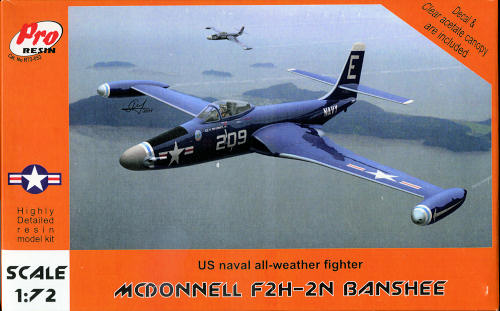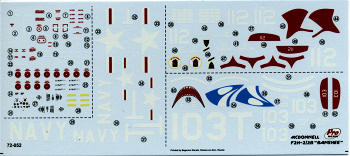
Pro-Resin 1/72 F2H-2N Banshee
| KIT #: | R72-053 |
| PRICE: | $ |
| DECALS: | Two options |
| REVIEWER: | Scott Van Aken |
| NOTES: | SResin kit with vacuformed canopies |

| HISTORY |
The McDonnell F2H Banshee was a single-seat carrier-based jet fighter aircraft deployed by the United States Navy and United States Marine Corps from 1948 to 1961. It was one of the primary American fighters used during the Korean War and was the only jet-powered fighter ever deployed by the Royal Canadian Navy, serving the RCN from 1955 until 1962. The aircraft's name is derived from the banshee of Celtic mythology.
Despite the Navy's accepting the F2H-1, it was the more capable F2H-2 that was most widely used. With newer Westinghouse J34-WE-34 3,250 lbf (14.5 kN) thrust engines, it had improved performance. The wing was modified and strengthened to add provisions for 200 gal (760 l) wingtip fuel tanks; unlike the contemporary USN F9F Panther, the Banshee's wingtip tanks were detachable. Two armament pylons were added under each stub and outboard wing, for a total of eight, allowing the aircraft to carry a maximum stores load of 1,580 lb (454 kg), consisting of four 250 lb (113 kg) bombs and four 5-in (12.7 cm) unguided rockets. The “kneeling” nose gear was omitted from the F2H-2 and most other subsequent Banshee variants.
The F2H-2N was a night fighter variant outfitted with a 2 ft 10 in (0.86 m) longer nose that housed a Sperry Corporation AN/APS-19 radar unit. The cannons were moved rearwards in the nose to make room for the radar. One F2H-2N, BuNo 123311, was eventually returned to McDonnell to serve as the prototype for the enlarged and enhanced F2H-3 and F2H-4 series. A handful of F2H-2Ns retained the "kneeling" nose feature of the earlier F2H-1.14 F2H-2N aircraft were built.
| THE KIT |
 ProResin kits have always been well molded and generally fit quite well. Their tan resin is fairly free from any casting errors, though one does find a pin hole from time to time. These parts are all in a sealed polybag and due to the weight of some of the parts, it is not uncommon to find some of the smaller bits have broken away from the pour stubs. Such was the case with this one. About the only part that will require some careful repair is the control stick, which broke away from its base.
ProResin kits have always been well molded and generally fit quite well. Their tan resin is fairly free from any casting errors, though one does find a pin hole from time to time. These parts are all in a sealed polybag and due to the weight of some of the parts, it is not uncommon to find some of the smaller bits have broken away from the pour stubs. Such was the case with this one. About the only part that will require some careful repair is the control stick, which broke away from its base.
Once the parts are removed from their pour stubs and any seams lightly sanded down, this kit builds like any styrene kit aside from needing super glue to assemble the kit. Some have gone the extra step of cleaning all the parts in warm soapy water or rubbing them down with lacquer thinner to remove molding release oils, but judging from past builds, that may well not be necessary as modern casting techniques have made those agents redundant.
Detailing is excellent with fine, crisp engravings on the surface and well done inner detail cast into some parts. The ejection seat has the belts molded in place so just needs some painting to help things. The instructions show what looks to be a decal for the instrument panel, but none is provided. None is really needed as the detail on the resin panel is very good. Landing gear is well done with the proper number of struts and bits. The kit does have some very small parts so beginners should look elsewhere for their first resin kit.
 The tip tanks have separate nose caps while the intakes and exhaust have reasonably good depth. There are intake compressor pieces that can be installed to add detail. These fit into one-piece wing sections which then butt to the fuselage. The fin and tail planes are separate butt fit pieces as well. One thing that I am not fond of is that the lower canopy frame is resin while the clear part is separate. I have never been able to successfully join these two pieces even in a styrene kit without a visible join area. There are two clear vac canopies given and if you want to pose the canopy open, this must be cut. As some early -2Ns had the kneeling nose gear feature, Pro Resin offers that as an option. The instructions state that 10 grams of nose weight will be needed and I would recommend grinding out some of the solid nose in order to fit this as close to the front as you can.
The tip tanks have separate nose caps while the intakes and exhaust have reasonably good depth. There are intake compressor pieces that can be installed to add detail. These fit into one-piece wing sections which then butt to the fuselage. The fin and tail planes are separate butt fit pieces as well. One thing that I am not fond of is that the lower canopy frame is resin while the clear part is separate. I have never been able to successfully join these two pieces even in a styrene kit without a visible join area. There are two clear vac canopies given and if you want to pose the canopy open, this must be cut. As some early -2Ns had the kneeling nose gear feature, Pro Resin offers that as an option. The instructions state that 10 grams of nose weight will be needed and I would recommend grinding out some of the solid nose in order to fit this as close to the front as you can.
| CONCLUSIONS |
It all makes for a nice model and an interesting comparison to the other Banshee kits available in 1/72 scale.
| REFERENCES |
February 2012
Thanks to ProResin for the preview kit. If your dealer does not carry it, ask them to order one for you.
If you would like your product reviewed fairly and quickly, please contactme or see other details in the